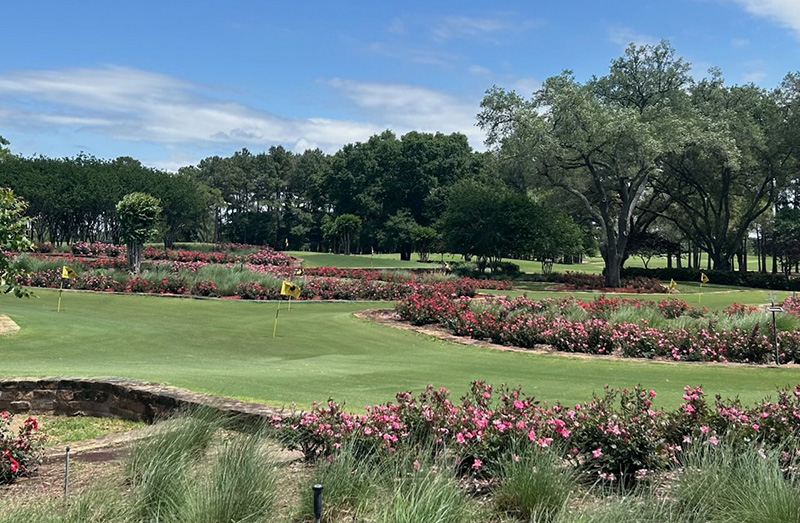
Brian Johnson, GCSAA Class A superintendent and general manager at Sand Hill Farm Golf Course in Waller, Texas, has a background in golf course architecture. Images courtesy of Sand Hill Farm
Editor’s note: The following article was supplied by Silva & Johnson. All product claims, research cited and other information is directly from the company.
Golf industry careers rarely move in a straight line. By the time Brian Johnson graduated from Iowa State with his degree in Landscape Architecture 25 years ago, he’d already done an internship in Bob Lohmann’s office. In 2001, when he landed a full-time course-design gig with the firm Cornish, Silva & Mungeam, his career wasn’t just confirmed. It was off and running.
By 2005, Johnson was itching for more responsibility. Rex VanHoose (whom he’d met during that internship) offered him the chance to oversee original design jobs in the field. So, off he went to Houston, Texas where he spent four years as a design associate for Jacobsen Hardy Course Design.
Johnson, now 48, recounts all these stops on his uncommon golf journey while showing off Sand Hill Farm, a one-of-a-kind, soon-to-be-12-hole private club in northwest Houston. In 2008, when the bottom fell out of the course development business, Jacobsen Hardy didn’t have enough work to keep Johnson employed. He took a job on the construction crew building Sand Hill Farm. Today, he’s the GCSAA Class A superintendent and general manager.
“Back in 2008, there was no work for me or a lot of people in the design business,” Johnson recalls, stopping to check on one of the new green pads at SHF, where he and VanHoose recently added holes 10, 11 and 12. They will open for play Feb. 1.
“So, I threw myself into my work here. Joined GCSAA, got married and had kids, started a management company to run the place. And I gotta say: It’s been great. The owners here have been fantastic. I’m also ‘head professional,’ a hat I wear mainly during outings — we host 25 of those each year. My dad was a teaching pro, and those are some of my best days.
“But the design thing never really left me.”
Golf course design wasn’t done with Johnson, either. In August of 2025, veteran architect Brian Silva invited Johnson to partner in a new design firm, Silva & Johnson. It was the continuation of a long-standing professional relationship.

One of 18 holes on Sand Hill Farm's 25,000-square-foot MiniVerde putting course.
As a full-time employee in the early 2000s, Johnson had assisted Silva and his partners mainly with original design projects — a discipline he continued with Jacobsen Hardy. Like many architects post-Recession, Johnson shifted gears: He looked after Sand Hill Farm while assisting Silva in a series of high-profile, classic course refurbishments. Since 2009, Johnson has done the lion’s share of Silva’s drawings and centerline plans, grading and drainage schemes.
Bit by bit — mowing greens and managing Poa by day; recreating Seth Raynor green complexes by night — the education of Brian Johnson continued apace. When the 72-year-old Silva suggested they partner up last winter, Johnson recognized an opportunity he’d long been waiting and preparing for. Silva, a former USGA agronomist, also recognized the opportunity to pay things forward.
“More than 40 years ago, Geoffrey Cornish — who got his start as an agronomist working for Stanley Thompson in the 1930s — extended to me the same sort of partnership opportunity,” Silva says. “I’ve designed alongside Brian Johnson for the better part of 25 years now. He’s as good a strategist as there is working today, and now he’s got hands-on maintenance and management experience that will resonate with our clientele. I’m eager for him to see these places in person. I have always found his design input to be nothing short of fascinating.
“Still, I might not have recommended this move 10 or 15 years ago. There wasn’t enough work out there. Today there is. This move means Brian, who brings so much to the table, can really spread his wings — and we can accept commissions that previously did not make sense, not for a lone ranger with grandkids. I’m excited to pass the torch while there’s still time to work together in earnest.”
Three high-profile renovations will dominate the partnership’s calendar in 2025-26. The first is already underway at Old Westbury Golf and Country Club, on Long Island, where Silva and Johnson are reshaping 18 holes originally designed by William Mitchell and nine by Gil Hanse. All 27 putting surfaces and surrounds are under construction this fall.
In the spring of 2026, a new irrigation installation will conclude, along with tee and fairway bunker renovations, and major fairway re-delineations. Also in 2026, the new partners will start similarly comprehensive refurbishments at Boca Raton Golf & Country Club (Donald Ross/William Flynn) on the east coast of Florida, and the 18 holes at San Antonio Country Club (Alex Findlay/A.W. Tillinghast).
Because Johnson has worked with Silva since 2009, there will be very little ramp-up required. At both San Antonio and Old Westbury, Johnson did all the AutoCad plan production, hole strategies, grading and drainage development, turf specifications, and detailed hole renderings that enabled the master plan process.
“It gives me a great deal of pleasure knowing that Brian will actually get to see these places in person,” Silva points out. “As a partner.”

Sand Hill Farm's nine-hole course will see three additional renovated holes in February.
Getting soil specific
No matter who shows up for site visits, the principals at Silva & Johnson will pack a wealth of agronomic insight.
“I do believe there’s a special understanding that develops when a course architect is also the guy taking care of the finished product,” explains Johnson. “Add another layer of learning and nuance when it comes to fitting that maintenance bottom line into an overall facility operations budget. And scheduling: I’ve learned how important that is to the maintenance process. It’s been an incredible, full spectrum learning experience at Sand Hill Farm — a sort of big-picture perspective that, today, we’re able to share with all our design clients.
“Drilling down, it’s all site and soil specific. We’re lucky here at Sand Hill Farm to have good, sandy loam. We’re not at a disadvantage in that way, compared to other courses in Houston. We have 419 on fairways, tees and rough; MiniVerde on the greens. Our course has some weed pressure — crabgrass, goose grass and sedges in the spring/summer — and we are always looking out for resistant poa in the winter. Our biggest issues result from having no continuous cart paths here. There’s some wear and tear for a place that does only 7,000 rounds a year. Keeping those traffic areas looking good is our biggest challenge.”
It’s one thing to develop a long-term connection with a course property, but Johnson’s career arc, maturation and experience have all been inextricably tied to Sand Hill Farm. In October of 2008, he left Jacobsen Hardy to join Kecchi Construction in building the course. He grew in the nine holes, then became superintendent and GM. He formed a management company that will continue to operate the club going forward.
Prior to the new three-hole addition, he and VanHoose designed and built an 18-hole, 25,000-square-foot MiniVerde putting course that plays through formal rose and landscape beds.
“Brian Johnson isn’t just determined,” VanHoose says, “he’s versatile and maybe the quickest study I’ve ever come across. He’s done such an amazing job at Sand Hill Farm. I think his best design work is ahead of him.”
Johnson says he’s been incredibly fortunate in the mentor department.
“The owners here have a real vision for this property, and it’s been my job to help them realize that vision — like architects are supposed to do, for their clients. For example, they planted live oaks and willow oaks in the 1960s and they’ve grown into beautiful, multi-stemmed specimen trees today. They’re special, so we protected them on the drip line. No hard slopes going down into those trees. As a result, the grading here on the big course is pretty soft, but it ties well into those trees.
“Rex and I are super proud of what we’ve built here. We got voted the second best nine in the state [there are 200 in Texas]. Brian [Silva] thought this was one of best nines he’d ever been on.”
Silva knows his way around that subject. His vast Ross-renovation portfolio includes Whitinsville (Mass.) Country Club, ranked #2 on GOLF Magazine’s 2020 ranking of the Top 50 Nines on Earth. In the 1990s, he eliminated another from consideration by adding nine to the esteemed, Ross-designed Rolling Rock Club in Laughlintown, Pa.
The senior statesman at Silva & Johnson remains very much in demand on the renovation and restoration front — a niche that still dominates the North American course-design market. Silva’s credentials have arguably shined even more brightly post 2008, as he carefully restored vintage elements of Ross (at Seminole, Biltmore Forest, Maketewah and Brookside in Columbus, Ohio), Ross and Tom Bendelow (at Brookside in Columbus, Ohio), C.B. Macdonald/Seth Raynor (at Fox Chapel, Everglades Club, Metairie CC just west of New Orleans) and Tillinghast (at Baltimore Five Farms and today at San Antonio CC).
“I’ve gotta be honest: Brian Johnson’s skills made much of that work possible — in a back-office respect, but also strategically,” Silva says. “When my original design at The Renaissance Club [Haverhill, Mass.] was being planned, for example, I shared my routing and hole strategies with my colleagues at CSM, partners and associates. That’s just something we did; always good to get another set of eyes… Well, that was 20 years ago. Brian was just a kid! But he got back to me with some stuff that knocked my socks off. Superb. A half-dozen of those holes today are his work.”
It's officially their work now.
“Brian has been a such a generous mentor to me through the years,” Johnson says. “To be out front a bit more, as a lead designer and his partner? It’s a dream come true.”
Hal Phillips is the managing director of Mandarin Media and a frequent contributor to GCM.